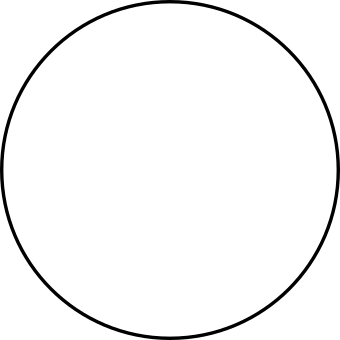Corella, Bohol
Corella, officially the Municipality of Corella (Cebuano: Lungsod sa Corella; Tagalog: Bayan ng Corella), is a 5th class municipality in the province of Bohol, Philippines. According to the 2015 census, it has a population of 8,479 people.[3]
Corella | |
|---|---|
| Municipality of Corella | |
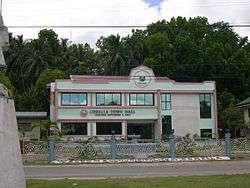 Town Hall | |
 Seal | |
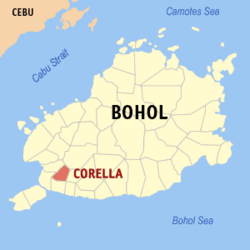 Map of Bohol with Corella highlighted | |
OpenStreetMap 
| |
.svg.png) Corella Location within the Philippines | |
| Coordinates: 9°41′N 123°55′E | |
| Country | |
| Region | Central Visayas (Region VII) |
| Province | Bohol |
| District | 1st District |
| Founded | 3 December 1879 |
| Barangays | 8 (see Barangays) |
| Government | |
| • Type | Sangguniang Bayan |
| • Mayor | Hilario D. Tocmo |
| • Vice Mayor | Maria Asuncion B. Daquio |
| • Congressman | Edgardo M. Chatto |
| • Electorate | 5,725 voters (2019) |
| Area | |
| • Total | 37.22 km2 (14.37 sq mi) |
| Population (2015 census)[3] | |
| • Total | 8,479 |
| • Density | 230/km2 (590/sq mi) |
| • Households | 1,900 |
| Economy | |
| • Income class | 5th municipal income class |
| • Poverty incidence | 13.98% (2015)[4] |
| • Revenue (₱) | 48,851,238.22 (2016) |
| Time zone | UTC+8 (PST) |
| ZIP code | 6337 |
| PSGC | |
| IDD : area code | +63 (0)38 |
| Climate type | tropical monsoon climate |
| Native languages | Boholano dialect Cebuano Tagalog |
Located 10 km (6.2 mi) northeast of Tagbilaran, it may have been named after a town in the province of Navarre in northern Spain.[5]
Corella is known primarily as the home of the endemic Philippine tarsier, one of the world's smallest primates. The 7.4-hectare (18-acre) Philippine tarsier sanctuary run by the Philippine Tarsier Foundation, as well as the Research and Development Center, is in Canapnapan, three kilometres (1.9 mi) east of the centre of town.
The people of Corella are predominantly conservative Roman Catholics belonging to the parish of Our Lady of the Village whose feast is celebrated on 27 April.
History
Its former name was Nug‑as before it obtained its present name, Corella. It was then a barrio of Baclayon. The adoption of the name Corella was made at the behest of Fr Jose Maria Cabañas del Carmen, then the parish priest of Baclayon and endorsed by Fr Felix Guillen de San Jose, the first Spanish priest. Corella was a name of a village in Navarra, Spain where this town's patroness, Nuestra Señora del Villar, showered miracles.
The creation of this town was due to the efforts of its inhabitants including Isidoro Ramo, who became its first gobernadorcillo.
The stone church and the convent were constructed during the tenure of Fr Felix Gullen and completed by later priests, one of them being Fr Dionisio Llorete who also spearheaded the erection of two stone school buildings and the municipal building during the term of the gobernadorcillo, Celedonio Sayon. But the construction of Corella's present concrete church began in 1924 under Fr Pedro Montelbon, the parish priest of Tagbilaran who took over the administration of the Corella parish after the incumbent, Fr Eugenio Desamparados left.
A battle of principles, rights, obligations, and duties raged in the municipality in 1920 between Simeon Sambola, the parish priest and the municipal president Nicanor C. Tocmo who were at loggerheads on the matter of school administration. From the pulpit, Fr Simeon lambasted the municipal administration and condemned the teachings in Corella schools as having originated from the mouth of hell. Enrollment in the school greatly diminished. Only close family friends and relatives of president Tocmo sent their children to school. The local civil administration complained to the provincial and national authorities. After a fact-finding investigation by the Department of Public Instruction whose report was submitted to the Governor-General, Fr Simeon was removed.
During the Japanese occupation, the area at a distance halfway between Corella and Gaboc was "no-man's land". Several civilians were arrested there by the Japanese and executed on the spot. Honorio Butawan, a bolo volunteer, was caught by the enemy, and taken to Tagbilaran never to return. Other civilians of Corella suffered instant death from the Japanese as the latter tried to escape the US army of liberation.
In October 1944, Capt. Martin Maliwanag, a guerrilla leader under Major Ismael Ingeniero established his headquarters in Corella, making the convent his command post and the primary school building east of the town plaza his detention cell. Several Filipino JCs (Japanese Constabulary) surrendered voluntarily. The first to surrender on 29 October 1944 was Lt. Victorio Sumodabila. He was shot on the spot by Capt. Maliwanag. Four other JCs from Corella who were killed and buried in common grave of Corella were Dandong Lamayo, his brother Fermin Lamayo, Felicisimo Guscal, and his brother-in-law, Celistino Formentera. In all, there were nine Filipino JCs who met their violent deaths in Corella on orders of Capt. Maliwanag, who met his own death when he attacked the Japanese garrison in Gaboc. His body was buried in the same cemetery as his victims. It was Maliwanag's men who captured the puppet Japanese governor Agapito Hontanosas.
During the guerrilla period, Corella had four mayors closely succeeding each other:
- The Commonwealth-elected mayor Catalino C. Vale, who was suspected to be a Japanese puppet, was detained in Behind The Clouds (San Jose) in Batuan, where the Bohol Area Command (BAC) of the guerilla forces had its headquarters.
- Roman Calotes Tocmo who was named acting vice mayor by the guerillas and Tiburcio Aranas who was the acting mayor.
- After Aranas's death, Jose Clarin replaced him.
- When Clarin went on leave, he was substituted by Isaac Filo.
Barangays
Corella comprises 8 barangays, all classified as rural:
|
|||||||||||||||||||||||||||||||||||||||||||||||||||||||||||||||||||||||||||||
Climate
| Climate data for Corella, Bohol | |||||||||||||
|---|---|---|---|---|---|---|---|---|---|---|---|---|---|
| Month | Jan | Feb | Mar | Apr | May | Jun | Jul | Aug | Sep | Oct | Nov | Dec | Year |
| Average high °C (°F) | 28 (82) |
28 (82) |
29 (84) |
31 (88) |
31 (88) |
30 (86) |
29 (84) |
29 (84) |
29 (84) |
29 (84) |
28 (82) |
28 (82) |
29 (84) |
| Average low °C (°F) | 22 (72) |
22 (72) |
22 (72) |
23 (73) |
24 (75) |
24 (75) |
24 (75) |
24 (75) |
24 (75) |
23 (73) |
23 (73) |
22 (72) |
23 (74) |
| Average precipitation mm (inches) | 102 (4.0) |
85 (3.3) |
91 (3.6) |
75 (3.0) |
110 (4.3) |
141 (5.6) |
121 (4.8) |
107 (4.2) |
111 (4.4) |
144 (5.7) |
169 (6.7) |
139 (5.5) |
1,395 (55.1) |
| Average rainy days | 18.6 | 14.8 | 16.5 | 16.7 | 23.9 | 26.4 | 25.6 | 24.1 | 24.4 | 26.3 | 23.7 | 20.5 | 261.5 |
| Source: Meteoblue (modeled/calculated data, not measured locally) [7] | |||||||||||||
Demographics
|
| ||||||||||||||||||||||||||||||||||||||||||||||||
| Source: Philippine Statistics Authority[3][6][8][9] | |||||||||||||||||||||||||||||||||||||||||||||||||
From 1990, a marked decrease in population is noted. Groups of people migrated to other parts of the country, such as Mindanao, where they founded a new municipality, "New Corella".
Economy
Corella does not have any major industry. A great majority of the people of the town are engaged in small-scale home businesses.
Gallery
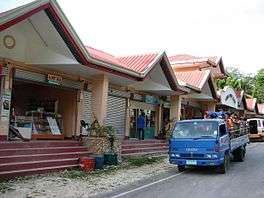 Public market
Public market Church of Nuestra Señora del Villar
Church of Nuestra Señora del Villar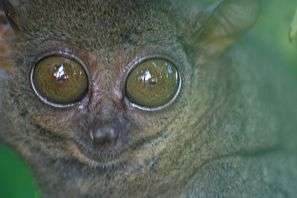 Philippine tarsier
Philippine tarsier A rice field in Corella
A rice field in Corella
References
- "Municipality". Quezon City, Philippines: Department of the Interior and Local Government. Retrieved 31 May 2013.
- "Province: Bohol". PSGC Interactive. Quezon City, Philippines: Philippine Statistics Authority. Retrieved 12 November 2016.
- Census of Population (2015). "Region VII (Central Visayas)". Total Population by Province, City, Municipality and Barangay. PSA. Retrieved 20 June 2016.
- "PSA releases the 2015 Municipal and City Level Poverty Estimates". Quezon City, Philippines. Retrieved 12 October 2019.
- "Ayuntamiento de Corella" (in Spanish). Retrieved 21 October 2014.
- Census of Population and Housing (2010). "Region VII (Central Visayas)". Total Population by Province, City, Municipality and Barangay. NSO. Retrieved 29 June 2016.
- "Corella: Average Temperatures and Rainfall". Meteoblue. Retrieved 9 May 2020.
- Censuses of Population (1903–2007). "Region VII (Central Visayas)". Table 1. Population Enumerated in Various Censuses by Province/Highly Urbanized City: 1903 to 2007. NSO.
- "Province of Bohol". Municipality Population Data. Local Water Utilities Administration Research Division. Retrieved 17 December 2016.
External links
| Wikimedia Commons has media related to Corella, Bohol. |
